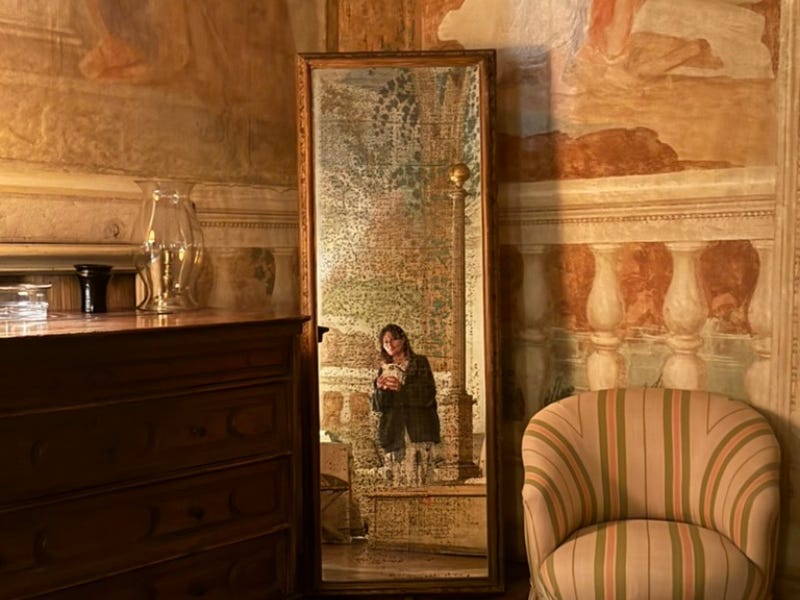Bell, Biennale and Bellinis: travel notes from Venice
Architecture, encounters, and the addresses you won’t find in a guidebook
It’s midnight in Venice. I am returning from a Biennale party with Lodovico and Martina, our footsteps echoing through the empty alleys. Across the water, the Marangona bell of the Basilica San Marco tolls faintly.
'When I was a teenager, I had to be home before the bell rang,' Lodovico tells us.
Born and raised here, he knows all the backstreets, steering us clear of the calli thick with tourists. As we walk, we pass the Scuola San Rocco and the Frari Church, along with their Tintoretto and Titian masterpieces. The Marangona’s tone is unmistakable and can be heard from all the corners of the city. I imagine the same sound echoing across the lagoon five centuries ago, calling young Venetians home.
In this timeless space, I am overwhelmed with serenity. Lodovico and Martina share their love for the Lido, the ultimate Venetian getaway come June—I have never been and mentally promise myself to go on my next visit as time is running out.
I am trying to process the past two days I spent in Venice. It’s not the first time I've been mesmerised by the splendour of the city, but it’s the first time I feel the incredible cultural pool of this European capital.
At La Malcontenta
I came here for the Architecture Biennale, an event that initially felt slightly intimidating to me but that left me reinvigorated and intellectually challenged. And tonight, at one of those parties only Venetians seem able to pull off—this one at the Malcontenta, a patinated Palladian villa restored with rare taste—I spoke with artists, designers, architects. For a moment, it felt like Venice was again the centre of the universe. The sheer splendour of the setting, the quality of the guests, the conversations… a rare fusion of international creativity and ancestral beauty.
Venice Now
A view from the Gritti’s terrace
'The city was fermenting before Covid,' Venetian artist Giorgio Andreotta Calò tells me. 'It was under pressure, heading toward collapse. But the pandemic disrupted everything. Now, there's a new energy.’
That energy is unmistakable. Venetians who once scattered across the world are beginning to find their way home. Lodovico, who works abroad, dreams of returning for good. Alvise, once based in Brussels, now lives in Venice with his Venetian wife and their two children, working remotely for the World Health Organisation. He reflects on the new wave of residents arriving from across Europe, while also voicing concern over the ever-looming presence of mass tourism—still a nightmare—and the steady exodus of locals (fewer than 50,000 people now live in the city centre). Yet he says all this as we sip cappuccinos in Campo Santa Maria Formosa, before climbing into his boat to escape to a nearby island for the afternoon. For all the misgivings, the dolce vita alla Veneziana looks pretty much part of his everyday life.
Dries Van Noten and Patrick Vangheluwe, whom I meet in Venice, also speak of their delight in the city’s rhythm—a new chapter unfolding. And the homecoming of Venetian architect Giulia Foscari feels like a sign: more people with vision and influence are imagining a life here again.
Meanwhile, the Biennale contributors, who come from all over the world, seem eager to connect and exchange ideas. Liz Diller, the Golden Lion-winning architect whose Canal café pavilion at the Arsenale serves free coffee made with filtered lagoon water, shares her anxieties about the state of the U.S. Beneath a frescoed ceiling, she listens intently, as though I might hold some answers she’s looking for.
The Biennale of Architecture
At the Giardini
This year’s Biennale title sets the tone: Intelligens—a reflection on how architecture might draw on different forms of intelligence, from the natural to the artificial to the collective, to confront crises that are no longer remote.
In today’s anti-woke climate, even the word lands like a provocation. It reclaims a notion —curious, inclusive, multidisciplinary—that is increasingly derided or dismissed. The Architecture Biennale has long been known for posing big, often unwieldy social questions, and just as often dismissed as elitist or overly academic. But this year feels different. There’s urgency now. Climate change, forced migration, inequality, warfare—these are increasingly closer to our sheltered Western world.
At the Arsenale, a room filled with roaring condenser units—those clunky air-conditioning boxes strapped to buildings—blasts out oppressive heat. The temperature becomes unbearable. The point is impossible to ignore: our comfort comes at a catastrophic cost.
The national pavilions respond—not just through architecture, but through the voices of sociologists, physicists, farmers, artists, and biologists. Spread across the Giardini and the Arsenale, they form a kind of mosaic: imperfect, sometimes chaotic, but undeniably compelling.
Not all are convincing. ‘Like school projects on psychedelic drugs,’ a Venetian friend muttered. But others challenge and move. And as I leave the Giardini, physically drained but mentally charged, I feel an unexpected sense of hope—in the sheer diversity of minds gathered here, confronting reality with deep thinking and care.
Pavilions that stayed with me
German Pavilion
Keep reading with a 7-day free trial
Subscribe to Eleonore's Whisper to keep reading this post and get 7 days of free access to the full post archives.








